The History Of Porsche Boxster

The Porsche Boxster is a mid-engined roadster built by Porsche. The Boxster is Porsche's first vehicle designed by Harm Lagaay from the beginning as a roadster; all previous Porsche convertibles were based on hardtop coupes.
The first-generation Boxster (the 986) was introduced in late 1996 as a 1997 model; it was powered by a 2.5 litre flat six-cylinder engine. In 2000, the new Boxster S variant was introduced with a larger 3.2 litre motor, and the base model received a more powerful 2.7 litre engine. In 2003, styling and engine output was upgraded on both variants.
In 2005, further updates were substantial enough that Porsche internally identified the Boxster as a new 987 model. The 987s were more powerful than the 986s; engine output increased yet further in 2007, when both Boxster models received the motors from the corresponding Porsche Cayman variants.
Production of the 986 began at the former Porsche 928 facility in Stuttgart, Germany in 1996. Valmet Automotive also manufactures Boxsters under contract to Porsche at a facility in Uusikaupunki, Finland. The Boxster was Porsche's biggest volume seller from its introduction in model year 1997 until the company introduced the Cayenne utility vehicle in model year 2003.
The Boxster's name is a portmanteau of the word "boxer", referring to the vehicle's horizontally-opposed or "boxer" engine, and the word "roadster", referring to the vehicle's convertible top.
Harm Lagaay's Boxster design study stimulated a commercial turnaround for Porsche after several difficult years of falling sales.
The first generation of the Boxster whose visual appearance was heavily inspired by the Porsche Spyder and Speedster as well as the Porsche 550 Spyder. The Boxster was released ahead of the release of its big brother, the 996. Through consultation with Toyota, Porsche greatly decreased the cost of manufacture, and introduced large scale sharing of components between its models. The 986 Boxster had the same bonnet, front wings, and distinctive 'fried-egg' headlight units as the 996. Its original 2.5L M96 engine shared the same architecture with the 3.4L engine used in the 996. Many believe the combination of the new Boxster / 911 styling and the reduced build costs through component sharing saved Porsche from being acquired by another car company.
All 986/ 987 Boxsters use the M96 water cooled, horizontally opposed ("flat"), six-cylinder engine. The M96 is the first completely water-cooled engine used in a production non-front-engined Porsche. In the Boxster the M96 is placed in a mid-engine configuration as opposed to the rear-engine placement in all 911s. The combination of the M96 and a mid-engine layout provide a low center of gravity, smoothness throughout the rev range, near perfect weight distribution, and neutral handling characteristics. Early production M96 engines had a small but significant number of engine failures due to cracked or slipped cylinder liners, but since a minor redesign in 2000 these problems have been resolved.
Boxster 986 model history
MY 1997- 2.5L 150kW (204PS; 201hp)
- 2.7L 162kW (220PS; 217hp)
- 3.2L 186kW (253PS; 249hp) Boxster S introduced
- 2.7L 170kW (231PS; 228hp)
- 3.2L 190kW (258PS; 255hp)
- 3.2L 194kW (264PS; 260hp) Boxster S 550 Spyder 50th Anniversary Edition limited to 1953 cars
The model received a minor facelift in 2003. The plastic rear window was replaced by a glass window. Porsche installed a different exhaust pipe and modified air intake. In addition, the often disliked orange "fried egg" front indicators were replaced with clear glass indicators, and the rear light cluster was also changed, with orange turn signals replaced with clear grey. The side marker lights on the front wings were changed from orange to clear, except for on American market cars, where they remained orange. The bumpers were also changed slightly for a more defined, chiselled appearance, and new wheel designs were made available.
Limited Editions
550 Spyder 50th Anniversary Edition
In 2004 the 550 Spyder 50th Anniversary Edition was released, a production run of just 1953 cars. The Anniversary Edition cars are all painted GT Silver Metallic, the same color as the car show version of the Carrera GT supercar, and had unique cocoa brown full leather interior as standard, with grey natural leather as a no-cost option. Each car also received special interior paintwork, high-end BOSE sound system, two-tone grey and silver 18" Carrera wheels (unpainted as another zero-cost option), 5mm (0.2in) wheel spacers, the Boxster S sport exhaust, the 030 option lower sports suspension, and a plate on the center console piece commonly known as the "batwing" showing the production number. On American market cars the rear turn signals were red, whereas they remained clear for the rest of the world.
The second generation of the Boxster (internally known as the 987) made its debut at the 2004 Paris Motor Show alongside the new 911 (997). The car became available for model year 2005.
In appearance the car remains very similar to the previous generation. The most obvious styling change is to the headlights, which now have a profile similar to those of the Carrera GT, Porsche's mid-engined supercar. The intake vents on the sides of the Boxster are now larger, with more pronounced horizontal slats and are coloured metallic silver, irrespective of the paint colour on the rest of the car. The wheel arches have been enlarged to allow wheels up to 19 inches in diameter, a first for the Boxster series. The most significant updates from the 986 series are in the interior, with a more prominent circular theme evident in the instrument cluster and cooling vents. Porsche claims that the 987 Boxster shares only 20% of its components with its predecessor, despite their being almost identical from the outside. The base engine is a 2.7L 176kW (240hp) flat-6, with the Boxster S getting a 3.2L 206kW (280hp) engine. The Cayman series is derived from the 987.
For the 2007 model year the base Boxster received a revised engine featuring VarioCam Plus to provide a 5hp (3.7kW) boost (245hp; the same as the Cayman). The Boxster S engine was upgraded from 3.2L to 3.4L, resulting in the production of 15 more hp (295hp; the same as the Cayman S). These upgrades made the Boxster series and the Cayman series equivalent in terms of horsepower.
Boxster 987 model history
MY 2005- 2.7L 176.5kW (240PS; 237hp)
- 3.2L 206kW (280PS; 276hp) Boxster S
- 2.7L 180kW (245PS; 241hp)
- 3.4L 217kW (295PS; 291hp) Boxster S
Limited Editions
RS60 Spyder
In November 2007, Porsche announced a commemorative RS60 Spyder edition of the Boxster to celebrate Porsche's 1960 win in the 12 Hours of Sebring in Florida. Only 1960 units in this series are to be produced worldwide, with approximately 800 slated for the U.S.; each bears a badge on the dash showing the car's production number. The RS60 Spyder comes in one color -- GT Silver Metallic; the standard interior is Carrera Red leather, with dark grey leather as an option. The RS60 comes standard with 19" SportDesign alloy wheels, Porsche's Active Suspension Management System, and a sports exhaust that boosts the engine output to 303PS (223kW). The base price for the RS60 Spyder is $64,900 USD.
Porsche Design Edition 2
Porsche also announced the production of limited Boxster S Porsche Design Edition 2, to be available on October 2008 as 2009 model. It features freer-flowing exhaust, which raises power from 295PS (217kW) at 6250 rpm to 303PS (223kW) at an identical 6250 rpm. It came with painted interior surfaces and gauges, white 19-inch wheels, and light gray stripes on the front fascia, hood, and bodyside, monochrome red taillights, white body. 500 are to be made for worldwide market, with 100 for the U.S. and Canada. It cost $66,900 USD.
2010 Boxster
In November 2008, at the Los Angeles International Auto Show, Porsche revealed the face-lifted 2009 Boxster and Boxster S. Both models feature a bump in power due to an increase in displacement and Porsche's use of Direct Fuel Injection, respectively, and both models are now available with Porsche's new 7-speed Porsche Doppelkupplungsgetriebe (PDK) dual clutch gearbox and new 6-speed manual gearbox. Displacement in the standard Boxster's flat-six engine increases from 2.7 to 2.9 liters, with a power increase of 10 horsepower. Use of Direct Injection in the Boxster S increases the output of the 3.4 liter flat-six engine from 295 to 310 horsepower. Cosmetic changes to the 2009 Boxster and Boxster S are minimal, however the interior was given a full re-design to reduce button clutter.
Within a year of marketplace acceptance in the United States, the original Boxster was the recipient of many awards, including those listed:
- Car & Driver – One of the 10 Best Cars of 1997
- Automobile – Automobile of the Year
- Motor – 1997 Performance Car of the Year
- Autocar – Best Roadster in the World
- Motorweek – 1997 Drivers Choice for Best Sports Car
- The Philadelphia Inquirer – Best Sports Car of the Decade
- Newsweek – One of the Best New Products of 1997
- BusinessWeek – One of the Best New Products of 1997
- American Marketing Association – Best New Product of 1997
- Automobile Journalists of Canada – 1997 Car of the Year
- Automobile Journalists of Canada – Best Design of 1997
The Boxster has been on Car and Driver magazine's annual Ten Best list nine times, from 1998 through 2003 and 2006 through 2008.
The Boxster S (986s) was rated as one of the top ten Porsches of all time by Excellence magazine.
The Boxster (in both 986 and 987 guise) is evo magazine's recommended buy in the 'Sports Car' category and has been ever since the model's introduction.
From Wikipedia, the free encyclopedia
More About Porsche Boxster
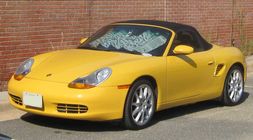
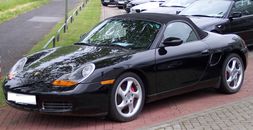
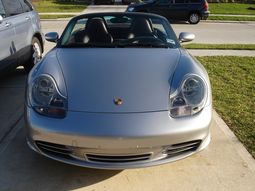
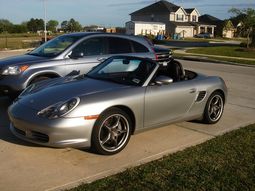
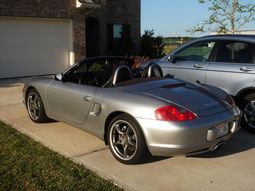
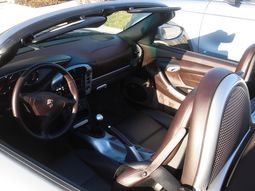
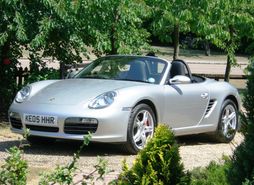
|